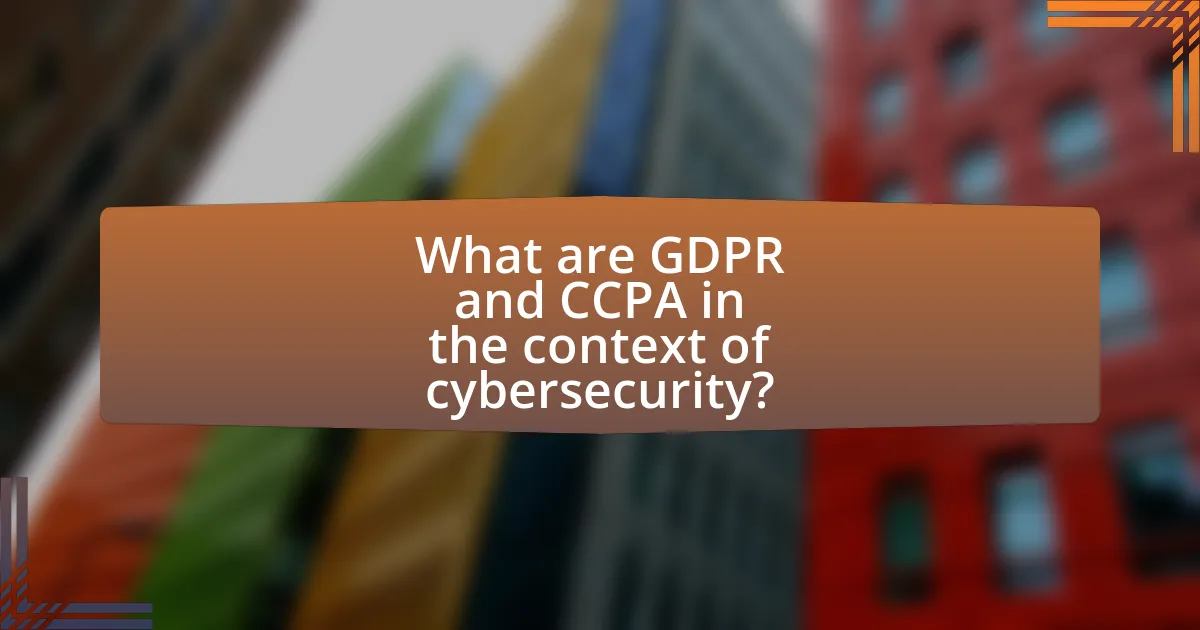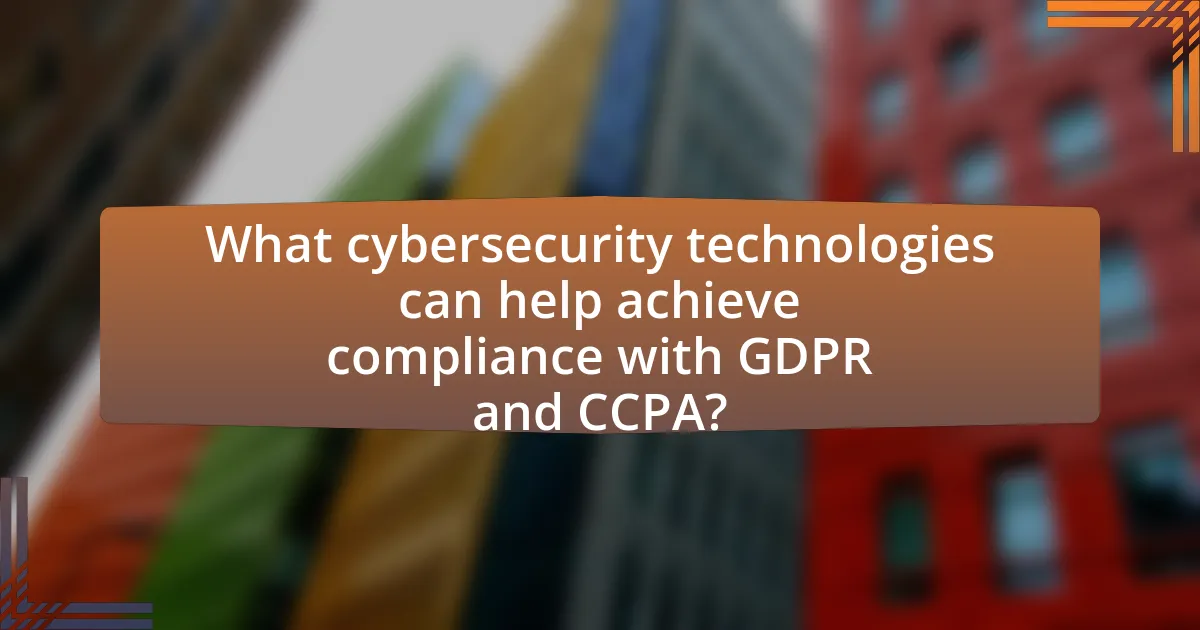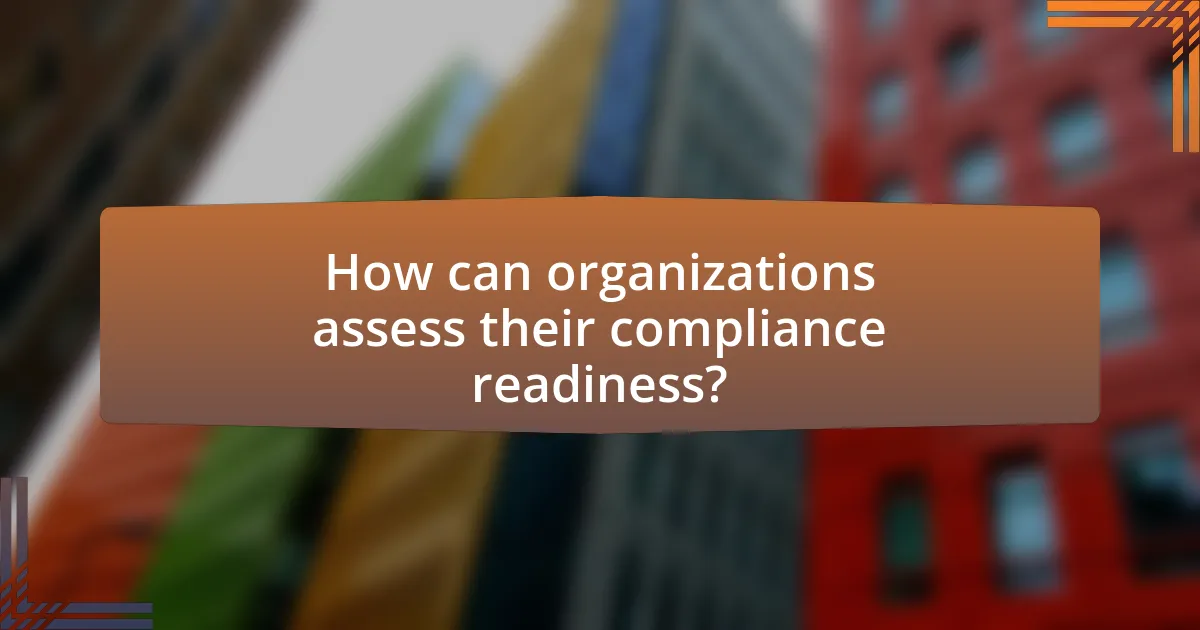The article focuses on the critical role of GDPR (General Data Protection Regulation) and CCPA (California Consumer Privacy Act) in shaping cybersecurity practices and enhancing data protection. It outlines the stringent requirements imposed by these regulations, including the necessity for explicit user consent, robust data security measures, and the rights of individuals regarding their personal information. Key principles of both regulations are discussed, along with the potential penalties for non-compliance and the importance of adopting cybersecurity technologies such as encryption and access controls. Additionally, the article emphasizes best practices for organizations to assess their compliance readiness and manage evolving regulatory requirements effectively.

What are GDPR and CCPA in the context of cybersecurity?
GDPR (General Data Protection Regulation) and CCPA (California Consumer Privacy Act) are legal frameworks designed to enhance data protection and privacy for individuals, significantly impacting cybersecurity practices. GDPR, enacted in the European Union in May 2018, mandates strict guidelines for data handling, requiring organizations to implement robust security measures to protect personal data, with penalties for non-compliance reaching up to 4% of annual global turnover. CCPA, effective from January 2020, grants California residents rights regarding their personal information, including the right to know, delete, and opt-out of the sale of their data, compelling businesses to adopt cybersecurity technologies that ensure data protection and transparency. Both regulations emphasize the importance of cybersecurity in safeguarding personal data, thus driving organizations to enhance their security protocols to comply with these stringent legal requirements.
How do GDPR and CCPA impact data protection practices?
GDPR and CCPA significantly enhance data protection practices by establishing stringent requirements for data handling and user consent. GDPR mandates that organizations obtain explicit consent from individuals before processing their personal data, ensuring transparency and user control over their information. CCPA similarly empowers consumers by granting them rights to know what personal data is collected, the ability to access that data, and the option to opt-out of its sale. These regulations compel businesses to implement robust data security measures, conduct regular audits, and maintain clear privacy policies, thereby fostering a culture of accountability and trust in data management.
What are the key principles of GDPR and CCPA?
The key principles of GDPR (General Data Protection Regulation) include data protection by design and by default, accountability, transparency, and the rights of individuals to access, rectify, and erase their personal data. GDPR mandates that organizations must implement appropriate technical and organizational measures to ensure data protection and must inform individuals about how their data is used. In contrast, CCPA (California Consumer Privacy Act) emphasizes consumer rights such as the right to know what personal data is collected, the right to delete personal data, and the right to opt-out of the sale of personal data. CCPA requires businesses to disclose their data collection practices and provides consumers with greater control over their personal information. Both regulations aim to enhance privacy rights and protect personal data, reflecting a growing global emphasis on data protection.
How do these regulations define personal data?
Regulations such as the General Data Protection Regulation (GDPR) and the California Consumer Privacy Act (CCPA) define personal data as any information that relates to an identified or identifiable individual. Under GDPR, personal data encompasses a wide range of identifiers, including names, identification numbers, location data, and online identifiers, which can directly or indirectly identify a person. The CCPA similarly defines personal data as information that identifies, relates to, describes, or can be associated with a particular consumer or household. This broad definition underscores the importance of protecting various types of information that can reveal personal identities, thereby ensuring compliance with privacy standards.
Why is compliance with GDPR and CCPA essential for organizations?
Compliance with GDPR and CCPA is essential for organizations to avoid significant legal penalties and maintain consumer trust. GDPR imposes fines of up to 4% of annual global revenue or €20 million, whichever is higher, while CCPA can impose penalties of up to $7,500 per violation. These regulations protect consumer data and privacy, requiring organizations to implement robust data protection measures. Non-compliance can lead to reputational damage, loss of customer loyalty, and increased scrutiny from regulators. Therefore, adherence to these laws is critical for legal protection and sustaining business operations in a data-driven economy.
What are the potential penalties for non-compliance?
The potential penalties for non-compliance with GDPR and CCPA can include substantial fines and legal repercussions. Under GDPR, organizations can face fines up to €20 million or 4% of their annual global turnover, whichever is higher, for serious violations. CCPA imposes fines of up to $7,500 per violation, with the possibility of additional penalties for non-compliance with consumer rights requests. These penalties are enforced to ensure adherence to data protection regulations and to protect consumer privacy rights.
How can compliance enhance customer trust and brand reputation?
Compliance enhances customer trust and brand reputation by demonstrating a commitment to ethical practices and data protection. When organizations adhere to regulations such as GDPR and CCPA, they signal to customers that their personal information is handled responsibly and securely. This adherence can lead to increased customer loyalty; for instance, a study by PwC found that 79% of consumers are concerned about how companies use their data, and 88% will not engage with a company if they have concerns about its security practices. Therefore, compliance not only mitigates risks but also fosters a positive brand image, ultimately enhancing customer trust.

What cybersecurity technologies can help achieve compliance with GDPR and CCPA?
Cybersecurity technologies that can help achieve compliance with GDPR and CCPA include data encryption, access controls, and data loss prevention (DLP) solutions. Data encryption protects personal data by converting it into a secure format, ensuring that unauthorized parties cannot access it, which is crucial for meeting GDPR’s data protection requirements. Access controls limit who can view or manipulate sensitive information, aligning with CCPA’s emphasis on consumer privacy rights. DLP solutions monitor and control data transfers, preventing unauthorized sharing of personal data, thus supporting compliance with both regulations. These technologies collectively enhance data security and privacy, which are fundamental principles of GDPR and CCPA.
How do encryption technologies support data protection?
Encryption technologies support data protection by converting sensitive information into unreadable formats, ensuring that only authorized users can access the original data. This process safeguards personal data from unauthorized access and breaches, which is crucial for compliance with regulations like GDPR and CCPA. For instance, according to the European Union’s GDPR guidelines, encryption is recognized as a valid method to mitigate risks associated with data processing, thereby enhancing the security of personal data. Additionally, the use of strong encryption algorithms, such as AES (Advanced Encryption Standard), has been shown to significantly reduce the likelihood of data breaches, as evidenced by various cybersecurity studies that highlight the effectiveness of encryption in protecting sensitive information.
What types of encryption are most effective for compliance?
The most effective types of encryption for compliance with regulations like GDPR and CCPA are AES (Advanced Encryption Standard) and RSA (Rivest-Shamir-Adleman). AES is widely recognized for its strong security and efficiency, making it suitable for encrypting sensitive data at rest and in transit. RSA, on the other hand, is commonly used for secure data transmission and digital signatures, ensuring data integrity and authenticity. Both encryption methods are endorsed by regulatory bodies and are critical in protecting personal data, thereby aiding organizations in meeting compliance requirements.
How does encryption mitigate data breaches?
Encryption mitigates data breaches by converting sensitive information into an unreadable format, ensuring that unauthorized individuals cannot access the data. When data is encrypted, even if it is intercepted during a breach, it remains protected because it requires a decryption key to be understood. For instance, the use of Advanced Encryption Standard (AES) has been widely adopted, providing a strong level of security; according to the National Institute of Standards and Technology (NIST), AES is considered secure against all known practical attacks. This means that organizations employing encryption can significantly reduce the risk of exposing personal data, thereby aiding compliance with regulations like GDPR and CCPA, which mandate the protection of personal information.
What role do access controls play in compliance?
Access controls are essential for compliance with regulations like GDPR and CCPA as they ensure that only authorized individuals can access sensitive data. By implementing strict access controls, organizations can protect personal information, thereby meeting legal requirements for data protection and privacy. For instance, GDPR mandates that organizations must implement appropriate technical and organizational measures to ensure a level of security appropriate to the risk, which includes access controls as a fundamental component. This compliance not only mitigates the risk of data breaches but also helps organizations avoid significant fines, as non-compliance can result in penalties of up to 4% of annual global turnover or €20 million, whichever is greater.
How can organizations implement effective access control measures?
Organizations can implement effective access control measures by adopting a multi-layered approach that includes role-based access control (RBAC), regular audits, and user training. RBAC ensures that individuals have access only to the information necessary for their job functions, minimizing the risk of unauthorized access. Regular audits help identify and rectify any access control weaknesses, while user training raises awareness about security protocols and the importance of safeguarding sensitive data. According to a 2020 study by the Ponemon Institute, organizations that implemented RBAC and regular audits experienced a 30% reduction in data breaches, demonstrating the effectiveness of these measures in enhancing security compliance with regulations like GDPR and CCPA.
What technologies are available for managing access controls?
Technologies available for managing access controls include Identity and Access Management (IAM) systems, Role-Based Access Control (RBAC), Attribute-Based Access Control (ABAC), Multi-Factor Authentication (MFA), and Single Sign-On (SSO) solutions. IAM systems centralize user identity management and enforce access policies, while RBAC assigns permissions based on user roles, enhancing security and compliance. ABAC provides more granular control by considering user attributes and environmental conditions. MFA adds an extra layer of security by requiring multiple forms of verification, and SSO simplifies user access across multiple applications with a single set of credentials. These technologies collectively support compliance with regulations like GDPR and CCPA by ensuring that access to sensitive data is properly managed and monitored.

How can organizations assess their compliance readiness?
Organizations can assess their compliance readiness by conducting a comprehensive compliance audit that evaluates existing policies, procedures, and controls against regulatory requirements. This audit should include a gap analysis to identify discrepancies between current practices and the standards set by regulations such as GDPR and CCPA. According to a report by the International Association of Privacy Professionals, organizations that perform regular compliance assessments are 50% more likely to identify and mitigate compliance risks effectively. Additionally, leveraging compliance management software can streamline the assessment process, providing real-time insights into compliance status and facilitating ongoing monitoring.
What steps should be taken to conduct a compliance audit?
To conduct a compliance audit, organizations should follow these steps: first, define the scope of the audit by identifying applicable regulations such as GDPR and CCPA. Next, gather relevant documentation, including policies, procedures, and records related to compliance. Then, assess the current compliance status by evaluating practices against regulatory requirements. After that, identify gaps and areas for improvement based on the assessment. Finally, develop an action plan to address identified deficiencies and implement necessary changes. This structured approach ensures that organizations effectively evaluate their compliance with cybersecurity regulations.
What tools can assist in the compliance audit process?
Compliance audit processes can be assisted by tools such as compliance management software, risk assessment tools, and data protection impact assessment (DPIA) tools. Compliance management software, like LogicGate or ComplyAdvantage, helps organizations track regulatory requirements and manage compliance documentation efficiently. Risk assessment tools, such as RiskWatch or RSA Archer, enable organizations to identify and evaluate risks associated with non-compliance. DPIA tools, including OneTrust and TrustArc, facilitate the assessment of data processing activities to ensure alignment with GDPR and CCPA requirements. These tools streamline the audit process, enhance accuracy, and ensure adherence to legal standards.
How can organizations identify gaps in their current practices?
Organizations can identify gaps in their current practices by conducting comprehensive audits of their cybersecurity measures against established compliance frameworks like GDPR and CCPA. These audits involve assessing existing policies, procedures, and technologies to determine their effectiveness in protecting personal data and ensuring regulatory compliance. For instance, a 2021 study by the International Association of Privacy Professionals found that organizations that regularly perform compliance audits are 30% more likely to identify and rectify gaps in their data protection practices. Additionally, organizations can utilize risk assessments and employee feedback to uncover areas where current practices may fall short, ensuring a proactive approach to compliance and data security.
What best practices should organizations follow for ongoing compliance?
Organizations should implement a continuous compliance framework that includes regular audits, employee training, and updated policies. Regular audits help identify compliance gaps and ensure adherence to regulations like GDPR and CCPA, which require organizations to protect personal data and maintain transparency. Employee training is essential to keep staff informed about compliance requirements and best practices, as human error is a significant factor in data breaches. Updating policies regularly ensures that organizations adapt to changing regulations and emerging threats, thereby maintaining compliance effectively. According to a report by the Ponemon Institute, organizations that conduct regular compliance audits are 50% less likely to experience data breaches, highlighting the importance of these practices.
How can regular training and awareness programs support compliance efforts?
Regular training and awareness programs enhance compliance efforts by ensuring that employees understand regulatory requirements and organizational policies. These programs provide essential knowledge about GDPR and CCPA, which helps mitigate risks associated with non-compliance. For instance, a study by the Ponemon Institute found that organizations with comprehensive training programs experienced 50% fewer data breaches compared to those without such initiatives. This demonstrates that informed employees are more likely to adhere to compliance protocols, thereby reducing the likelihood of costly violations and enhancing overall data protection practices.
What role does incident response planning play in maintaining compliance?
Incident response planning is crucial for maintaining compliance with regulations like GDPR and CCPA. It establishes a structured approach to identifying, managing, and mitigating security incidents, which is essential for adhering to legal requirements. For instance, GDPR mandates that organizations report data breaches within 72 hours, making an effective incident response plan vital for timely compliance. Furthermore, having a documented incident response strategy demonstrates due diligence and accountability, which are key components of both GDPR and CCPA compliance frameworks. This proactive stance not only helps organizations avoid potential fines but also builds trust with customers by ensuring their data is handled responsibly.
What are the common challenges organizations face in achieving compliance?
Organizations commonly face challenges such as understanding complex regulations, maintaining data security, and ensuring employee training in achieving compliance. The complexity of regulations like GDPR and CCPA often leads to confusion regarding requirements, making it difficult for organizations to implement necessary measures. Additionally, maintaining robust data security is crucial, as breaches can result in significant penalties; for instance, GDPR fines can reach up to 4% of annual global turnover. Furthermore, ensuring that all employees are adequately trained on compliance protocols is essential, as human error remains a leading cause of compliance failures.
How can organizations overcome resource constraints related to compliance?
Organizations can overcome resource constraints related to compliance by leveraging automation technologies and prioritizing risk-based approaches. Automation tools can streamline compliance processes, reducing the need for extensive manual labor and enabling organizations to allocate resources more efficiently. For instance, implementing automated compliance management systems can help track regulatory changes and manage documentation, which significantly lowers operational costs. Additionally, adopting a risk-based approach allows organizations to focus their limited resources on the most critical compliance areas, ensuring that they address the highest risks first. According to a report by Deloitte, organizations that utilize automation in compliance processes can reduce compliance costs by up to 30%, demonstrating the effectiveness of these strategies in overcoming resource constraints.
What strategies can be employed to manage evolving regulatory requirements?
To manage evolving regulatory requirements, organizations should implement a proactive compliance framework that includes continuous monitoring, regular training, and adaptive technology solutions. Continuous monitoring allows businesses to stay updated on regulatory changes, while regular training ensures that employees are informed about compliance obligations. Adaptive technology solutions, such as automated compliance management systems, can streamline the process of tracking and implementing regulatory updates. For instance, a study by Deloitte highlights that organizations using automated compliance tools can reduce compliance costs by up to 30%, demonstrating the effectiveness of technology in managing regulatory changes.
What practical tips can organizations implement for effective compliance with GDPR and CCPA?
Organizations can implement several practical tips for effective compliance with GDPR and CCPA, including conducting regular data audits, ensuring transparent data processing practices, and providing employee training on data protection. Regular data audits help organizations identify what personal data they hold, how it is processed, and whether it complies with regulations. Transparent data processing practices, such as clear privacy notices and obtaining explicit consent from users, are essential for compliance. Additionally, training employees on data protection principles and the specific requirements of GDPR and CCPA fosters a culture of compliance and reduces the risk of data breaches. These strategies are supported by the fact that organizations that prioritize data governance and employee awareness are less likely to face regulatory penalties.
